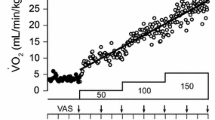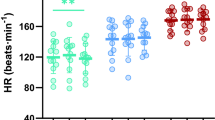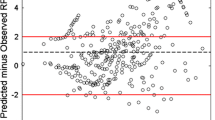Summary
The perceived exertion rating (RPE) scale of Borg was used to investigate the relationship between perceived exertion and pedalling rate. Normal subjects and patients with chronic obstructive lung disease (Cold) were studied in repeated test series. Work load, applied in a random order, varied from 2.5 to 10 mkp/s (patients) and 5 to 20 mkp/s (normals). Pedalling rate varied from 40 to 60, 80, 100 rpm. At constant work load, RPE decreases during increasing pedalling rate. With respect to validity, RPE, showing a closer relationship to work load than to heart rate, seems to reflect perception of physical stress rather than perception of physiological strain.
In addition, the results raise the question of standardization of pedalling rate in bicycle ergometry.
Similar content being viewed by others
References
Arstila, M.: Pulse-conducted triangular exercise-ECG test. Acta med. scand., Suppl. 529, 112 (1972)
Bannister, E. W., Jackson, R. C.: The effect of speed and load changes on oxygen intake for equivalent power outputs during bicycle ergometry. Int. Z. angew. Physiol. 24, 284–290 (1967)
Bar-Or, O., Skinner, J. S., Buskirk, E. R., Borg, G.: Physiological and perceptual indicators of physical stress in 41- to 60-year-old men who vary in conditioning level and in body fatness. Med. Sci. Sports 4, 96–100 (1972)
Borg, G.: Physical performance and perceived exertion. Lund: Gleerups 1962
Borg, G.: Perceived exertion as an indicator of somatic stress Scand. J. Rehab. Med. 2–3, 92–98 (1970)
Borg, G., Linderholm H.: Perceived exertion and pulse rate during graded exercise in various age groups. Acta med. scand. 181, 194–206 (1967)
Edwards, R. H. T., Melcher, A., Hesser, C. M., Wigertz, O., Ekelund, L. G.: Physiological correlates of perceived exertion in continuous and intermittend exercise with the same average power output Europ. J. clin. Invest. 2, 108–144 (1972)
Eiselt, E.: Die Bestimmung der Leistungsbreite Älterer MÄnner auf dem Fahrradergometer. In: I. Int. Sem. für Ergometrie (H. Mellerowicz, G. Hansen, eds.), pp. 40–51. Berlin: Ergon 1965
Ekblom, B., Goldbarg, A. A.: The influence of physical training and other factors on the subjective rating of perceived exertion. Acta physiol. scand. 83, 399–406 (1971)
Gaessler, G. A., Brooks, G. A.: Muscular efficiency during steady-state exercise: effects of speed and work rate. J. appl. Physiol. 38, 1132–1139 (1975)
Hermansen, L., Saltin, B.: Oxygen uptake during maximal treadmill and bicycle exercise. J. appl. Physiol. 26, 31–37 (1969)
Israel, S., Brenke, H., Donath, R.: Die AbhÄngigkeit einiger funktioneller Me\grö\en von der Trittfrequenz (Umdrehungszahl) bei der Fu\kurbelergometrie. Med. Sport (Berl.) 7, 65–68 (1967)
Israel, S., Köhler, E.: Die AbhÄngigkeit der Belastungs-Herzschlagfrequenz vom kardialen Leistungsvermögen. Z. Ärztl. Fortbild. 66, 413–416 (1973)
Löllgen, H., Ulmer, H.-V.: The preferred pedalling frequency of patients in bicycle ergometry. In: III. Int. Sem. für Ergometrie, Berlin 1972 (G. Hansen, H. Mellerowicz, eds.). Berlin: Ergon 1973
Löllgen, H., Ulmer, H.-V., Gross, R., Wilbert, G., Nieding, G. v.: Methodical aspects of perceived exertion rating and its relation to pedalling rate and rotating mass. Europ. J. appl. Physiol. 34, 205–215 (1975)
Pandolf, K. B., Noble, B. J.: The effect of pedalling speed and resistance changes on perceived exertion for equivalent power outputs on the bicycle ergometer. Med. Sci. Sports 5, 132–136 (1973)
Petrofsky, I. S., Rochelle, R. R., Burse, R. L., Lind, A. R.: The assessment of the static component in rhythmic exercise. Europ. J. appl. Physiol. 34, 55–64 (1975)
Schönholzer, G., Howald, H.: Ergometric methods for the determination of aerobic and anaerobic capacity. In: III. Int. Sem. für Ergometrie, Berlin, 1972 (G. Hansen, H. Mellerowicz, eds.). Berlin: Ergon 1973
Schürch, P. M., Hesch, I., Fotescu, M. D., Hollmann, W.: Der Einflu\ der Umdrehungszahl bei Fahrradergometerarbeit auf die kardio-pulmonale LeistungsfÄhigkeit von Radrennfahrern. Sportarzt u. Sportmed. 27, 7–12 (1976)
Shephard, R. J.: For exercise testing, please a review of precedure available to the clinician. Bull. Physio-path. Resp. 6, 424–478 (1970)
Skinner, J. S., Borg, G., Buskirk, E. R.: Physiological and perceptual reactions to exercise of young men differing in activity and body size. In: Exercise and fitness — 1969. (D. Franks, ed.). Chicago. The Atheletic Institute 1969
Skinner, J. S., Hutsler, R., Bergsteinova, V., Buskirk, E. R.: The validity and reliability of a rating scale of perceived exertion. Med. Sci. Sports 5, 94–96 (1973)
Stamford, B. A., Nobee, B. J.: Metabolic cost and perception of effort during bicycle ergometer work performance. Med. Sci. Sports 6, 226–231 (1974)
Stegemann, H. J., Ulmer, H.-V., Heinrich, K. W.: Die Beziehung zwischen Kraft und Kraftempfindung als Ursache für die Wahl energetisch ungünstiger Tretfrequenzen beim Radsport. Int. Z. angew. Physiol. 25, 224–234 (1968)
Szögy, A., Cherebetiu, G.: Herzvolumenaspekte bei Hochleistungssportlern. Sportarzt u. Sportmed. 23, 170–174 (1972)
Wahlund, H.: Determination of physical working capacity. Acta med. scand., Suppl. 215, 1–78 (1948)
Ulmer H.-V.: Die AbhÄngigkeit des Leistungsempfindens von der Tretfrequenz bei Radsportlern. Sportarzt u. Sportmed. 20, 385–390 (1969)
Ulmer, H.-V.: Die Tretgeschwindigkeit von Radsportlern bei Bahnrennen und Ergometerversuchen. Sportarzt u. Sportmed. 24, 77–82 (1973)
Ulmer, H.-V.: Zur Methodik, Standardisierung und Auswertung von Tests für die Prüfung der körperlichen LeistungsfÄhigkeit. Bd. 1 der Schriftenreihe Medizin des Bundesinstituts für Sportwissenschaft. Lövenich: Deutscher Ärzteverlag 1975
Wilbert, G., Gross, R., Ulmer, H.-V., Löllgen, H.: The perceived exertion (Borg) concerning endurance exercise on a bicycle ergometer and their importance in optimizing cyclic movements. III. Europ. Congr. Sports Medicine Budapest, 18.–24. 9. 1974
Author information
Authors and Affiliations
Rights and permissions
About this article
Cite this article
Löllgen, H., Ulmer, H.V. & Nieding, G.v. Heart rate and perceptual response to exercise with different pedalling speed in normal subjects and patients. Europ. J. Appl. Physiol. 37, 297–304 (1977). https://doi.org/10.1007/BF00430959
Received:
Accepted:
Issue Date:
DOI: https://doi.org/10.1007/BF00430959




